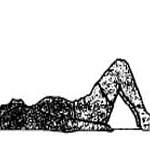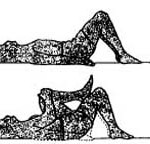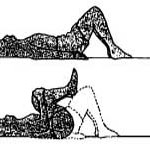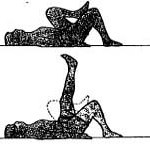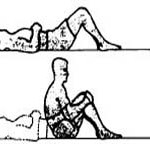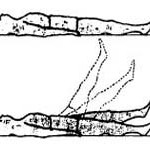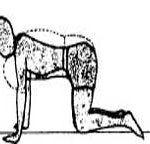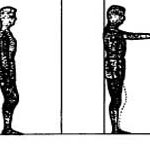Standing and Walking:
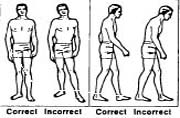 Try to toe straight ahead when walking; put most of your weight on your heels; hold your chest forward and elevate the front of the pelvis as if walking up an incline. Avoid wearing high heels. Stand as if you are trying to touch the ceiling with the top of yur head, eyes straight ahead. All the elements of good posture will flow from these simple maneuvers.
Try to toe straight ahead when walking; put most of your weight on your heels; hold your chest forward and elevate the front of the pelvis as if walking up an incline. Avoid wearing high heels. Stand as if you are trying to touch the ceiling with the top of yur head, eyes straight ahead. All the elements of good posture will flow from these simple maneuvers.
Sitting:
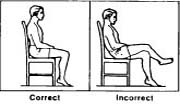 Sit on a hard-back chair with spine pushed back; try to eliminate the hollow in the lower back. If possible, elevate the knees higher than hips while in an automobile. Secretaries should adjust posture chairs accordingly. Sit all the way back in the chair with your back erect.
Sit on a hard-back chair with spine pushed back; try to eliminate the hollow in the lower back. If possible, elevate the knees higher than hips while in an automobile. Secretaries should adjust posture chairs accordingly. Sit all the way back in the chair with your back erect.
Lifting:
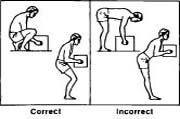 Bend your knees; squat and lift with your thigh muscles, not your back. Never bend over with your knees straight and lift with the upper torso. Move slowly and avoid sudden movements. Try to avoid lifting loads in front of you above the waste line. Avoid bending over to lift heavy objects from car trunks, as this places a strain on low back muscles
Bend your knees; squat and lift with your thigh muscles, not your back. Never bend over with your knees straight and lift with the upper torso. Move slowly and avoid sudden movements. Try to avoid lifting loads in front of you above the waste line. Avoid bending over to lift heavy objects from car trunks, as this places a strain on low back muscles
Sleeping:
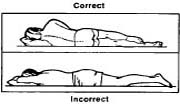 Sleep on a firm mattress; a ¾ inch plywood bed board is helpful and should be used with all but a very firm orthopedic mattress. With acute back pain, sleep with a pillow or blanket rolled under the knees and a pillow under the head. Keep your knees and hips bent when sleeping on your side.
Sleep on a firm mattress; a ¾ inch plywood bed board is helpful and should be used with all but a very firm orthopedic mattress. With acute back pain, sleep with a pillow or blanket rolled under the knees and a pillow under the head. Keep your knees and hips bent when sleeping on your side.
Driving:
 Use a firm seat with a padded plywood or special seal support. Sit close to the wheel with knees bent. On long trips, stop every one to tow hours and walk to relieve tensions and relax muscles
Use a firm seat with a padded plywood or special seal support. Sit close to the wheel with knees bent. On long trips, stop every one to tow hours and walk to relieve tensions and relax muscles
Working:
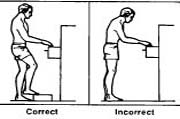 Try to avoid fatigue caused by work requiring long standing. Flex hips and knees by occasionally placing a foot on a stool or bench. Take exercises breaks from desk work by getting up, moving around and performing a few back exercises in the standing position.
Try to avoid fatigue caused by work requiring long standing. Flex hips and knees by occasionally placing a foot on a stool or bench. Take exercises breaks from desk work by getting up, moving around and performing a few back exercises in the standing position.
Question: Did you try these exercises? Were these exercises helpful?
